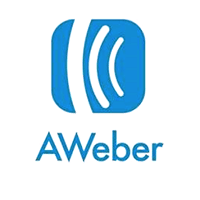Drip is a popular email marketing and sales automation platform designed specifically for ecommerce businesses. It allows you to segment contacts, set up complex automation workflows and scenarios, and integrate with ecommerce platforms like Shopify.
While this platform offers robust functionality for advanced email marketers, many users find themselves seeking alternative email marketing platforms for one reason or another. In this article, we’ll explore some of the top Drip alternatives worth considering.
Brevo
Brevo is packed with all kinds of useful email marketing tools, that make it the best Drip alternative
Omnisend
Omnisend is an excellent choice for various eCommerce activities and email marketing campaigns
HubSpot
Efficient lead flows and campaign sequences make HubSpot perfect for lead generation
ActiveCampaign
If you need advanced automation features, then ActiveCampaign is the email marketing tool for you
AWeber
AWeber is perfect for smaller businesses that are just starting out with email marketing campaigns
1. Brevo
Best Overall Drip Alternative (Free, then $25/Month)
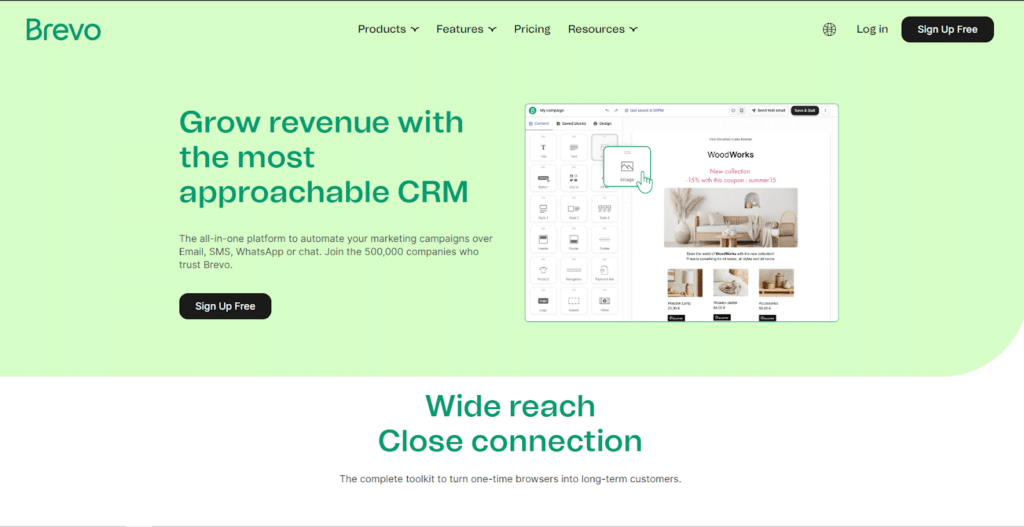
Brevo is an intuitive, easy-to-use email marketing platform built for small teams who want enterprise-level power without the typical complexity. It focuses on core email marketing features like customizable drag-and-drop email builders, automated workflows and journeys, advanced behavioral targeting and segmentation, detailed reporting, and seamless ecommerce integrations.
What makes Brevo a better alternative than Drip:
- More affordable pricing. Brevo starts at just $19/month for 5,000 contacts compared to Drip’s starting price of $49/month for 500 contacts. Their transparent, simple pricing stays low as you scale without sudden cost jumps.
- Superior deliverability with inbox placement rates over 99% ensures your messages reliably reach subscriber inboxes instead of getting blocked or falling into spam traps.
- Easy-to-use and intuitive builder allows solopreneurs to create beautiful, responsive email campaigns in minutes without coding skills or design resources. Pre-built templates and sections accelerate campaign creation further.
- Knowledgeable customer support specialists provide hands-on, customized guidance tailored to your specific needs and questions without extended wait times or frustrating ticket back-and-forth.
- Advanced integrations like Shopify, WooCommerce, Stripe, PayPal, and Zapier allows seamless connectivity with the other platforms small businesses rely on.
2. Omnisend
Best for eCommerce Brands (Free, then $16/Month)
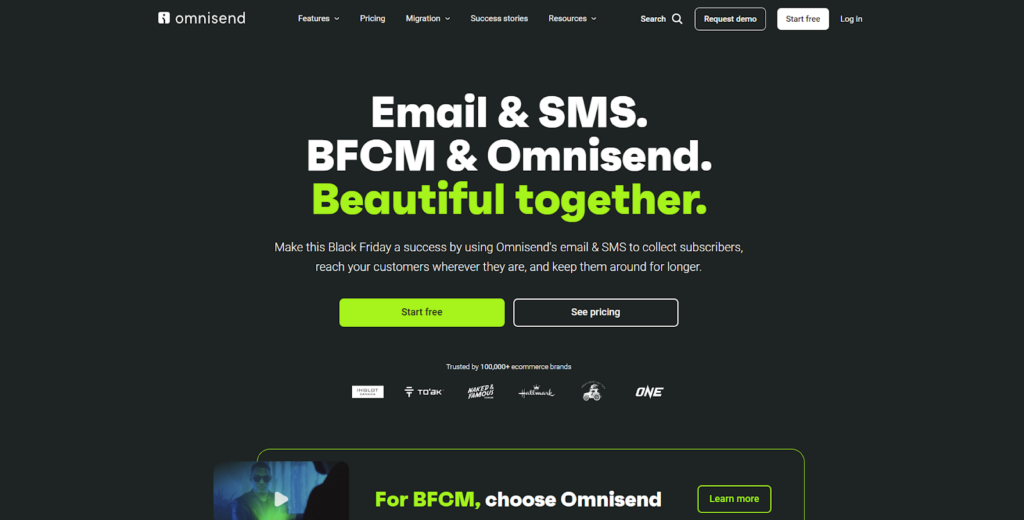
Omnisend specializes in advanced omnichannel marketing campaigns and automations tailored for direct-to-consumer ecommerce brands selling across multiple channels and platforms. Their robust feature set includes powerful segmentation tools, triggered campaigns based on customer behavior, SMS marketing, customizable post-purchase flows, and deep analytics.
What makes Omnisend a better alternative than Drip:
- Advanced segmentation capabilities allow you to divide contacts based on parameters like customer lifetime value, order frequency, products purchased, channel source and more to deliver hyper-targeted messaging.
- Post-purchase automation flows can be customized with granular triggers like time since last order, order value thresholds, product tags and more to keep driving repeat purchases.
- Built-in SMS marketing and messaging provide additional channels beyond email to reach customers on their terms. You can also append SMS opt-ins to existing subscriber lists.
- A focus on deliverability, inbox placement, and compliance infrastructure ensures your messages reliably land in subscriber inboxes instead of getting blocked or labeled as spam.
- Omnichannel analytics give clear visibility into performance across email, SMS, push notifications, Facebook and more from a unified dashboard to optimize your approach.
3. HubSpot
Best for Lead Generation (Free, then $20/Month)
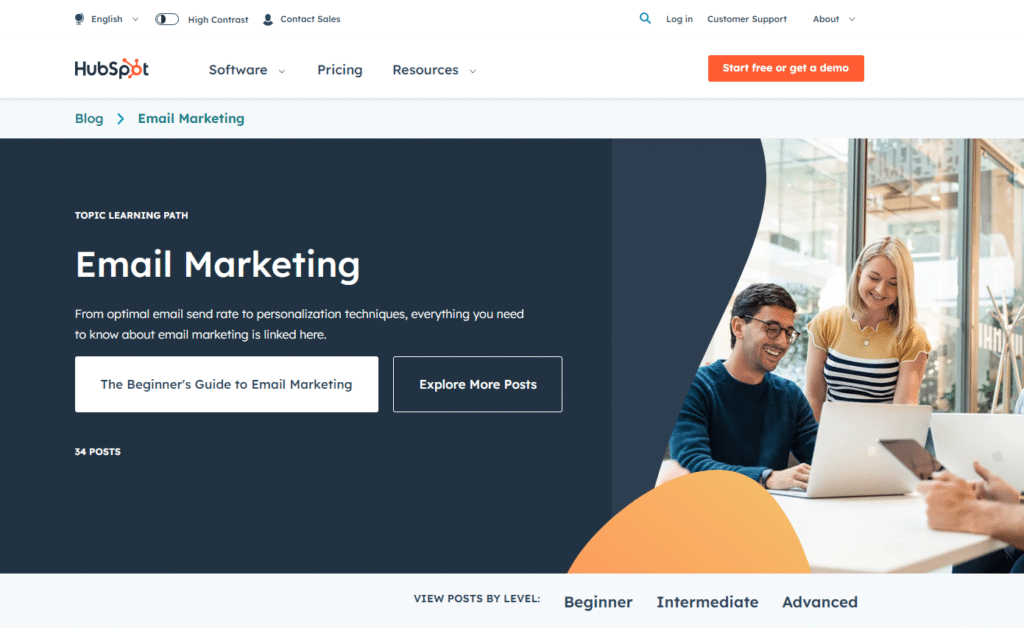
HubSpot goes far beyond basic email marketing to offer a complete inbound marketing, lead generation, and sales enablement platform tailored to the needs of sophisticated SaaS companies, digital agencies, and mid-market businesses.
Robust features for blogging, landing pages, forms, live chat, analytics and CRM integration allow for complete optimization of the entire lead-to-customer journey. The powerful email marketing tool deeply integrates with these other HubSpot products to deliver highly personalized and timed email campaigns triggered by site visits, form submissions, chat conversations and more.
What makes HubSpot a better alternative than Drip:
- Lead flows, sequences and campaigns can be triggered by form fills, site behavior, ad clicks, chat conversations and more to deliver perfectly timed, personalized messaging.
- Integration of email with HubSpot’s landing page builder, blog platform, pop-ups, surveys and contacts database create a streamlined inbound experience.
- Advanced analytics track opens, clicks, unsubscribes while also connecting email performance to the broader sales funnel and pipeline through CRM integration.
- A large gallery of professionally designed templates covers a wide variety of layouts for welcome series, product launches, newsletters and more. You can also build completely custom designs.
- Compliance assurances, data ownership protections, and top-tier security protocols provide peace of mind your customer data is managed responsibly.
4. ActiveCampaign
Best for Mid-Market B2B Companies and Advanced Automation ($29/Month)
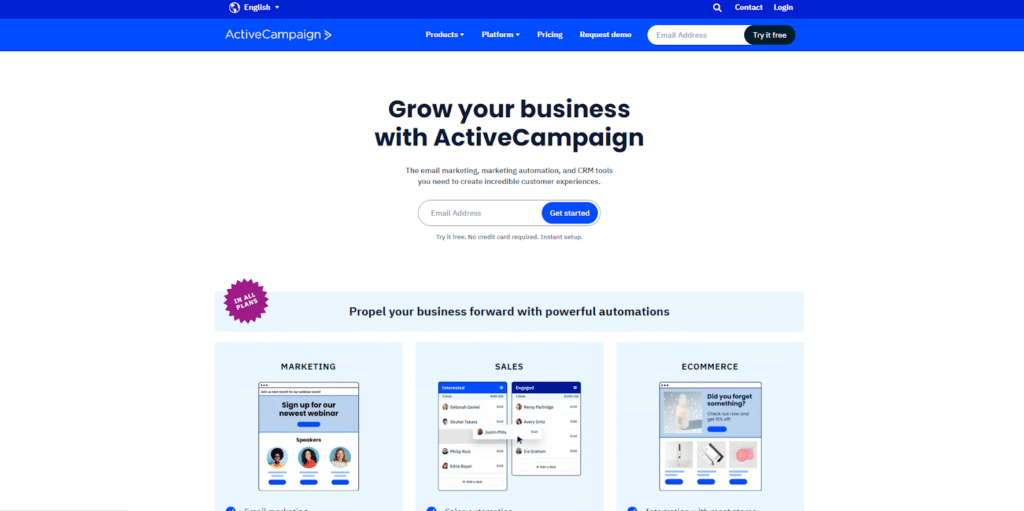
ActiveCampaign is an all-in-one customer experience automation platform tailored to the needs of mid-sized B2B companies managing multi-channel campaigns, advanced sales pipelines, and complex conversion funnels. It combines robust email marketing capabilities with equally powerful email marketing automation, CRM, analytics, attribution, and sales management tools.
This consolidated functionality makes ActiveCampaign uniquely appealing for growing companies with distributed sales teams looking to synchronize messaging across channels while closely tracking and optimizing the lead-to-customer journey.
Further benefits stem from deep platform integrations, event-based triggers tied to site/app activity, superior segmentation based on campaign and sales indicators, and an intuitive UI that keeps all critical conversion metrics centralized for easy monitoring.
What makes ActiveCampaign a better alternative than Drip:
- Site tracking and behavioral triggers facilitate timely, relevant messaging when contacts visit specific pages, click links in emails, fill out forms and more.
- Custom sales stages, deal values, activities and scores can be tracked right within subscriber profiles and leverage to segment and target outreach.
- SMS marketing and cart abandonment flows provide additional channels and hyper-targeted campaigns to re-engage customers.
- A unique 5-tiered sales pipeline dashboard gives visibility into email performance tied directly to pipeline movement including subscriber activities, trends, and bottlenecks.
- More affordable mid-tier pricing starts at just $9/month making it accessible for companies with smaller marketing budgets looking to consolidate platforms.
5. AWeber
Best for Small Businesses (Free, then $12.50/Month)
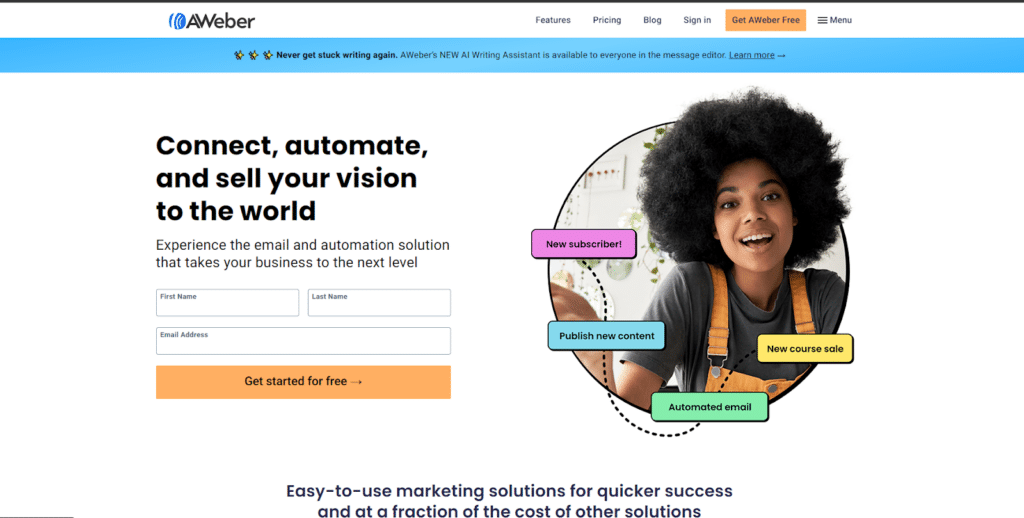
AWeber is an email marketing and automation platform built from the ground up for simplicity and ease-of-use, making it an appealing option for small business owners, entrepreneurs, bloggers, authors and anyone without extensive technical skills or specialized email marketing knowledge.
The straightforward feature set reduces complexity by focusing only on what’s essential for these groups: beautiful, professionally designed template options covering virtually any industry or niche with an easy-to-use form builder to quickly generate opt-in widgets for websites/landing pages to grow subscriber lists.
Beyond that, there are basic segmentation capabilities to target content by open/click rates, location and signup date without intensive list management; and clear, jargon-free educational blog posts, videos and guides catering specifically to the needs of solopreneurs and small business marketers.
Finally, robust customer support and onboarding assistance provided through phone, email, chat and community forums further smoothes out the learning curve.
What makes AWeber a better alternative than Drip:
- Over 600 professionally designed template options offer stylistic flexibility regardless of your industry or niche for crafting emails that resonate with your audience.
- An easy-to-use forms builder allows you to quickly generate customized opt-in widgets for your website, landing pages, pop-ups and more to easily grow your subscriber list.
- Simple segmentation by categories like open rate, click rate, location and signup date require minimal effort while still allowing for targeting relevant content.
- Educational blog content, videos and guides catering specifically to small biz owners and solopreneurs help you get up to speed fast without formal training.
- Exceptional customer support and onboarding assistance through phone, email, chat and community forums smooth out the learning curve further.
6. MailerLite
Best for Content Creators (Free, then $9/Month)
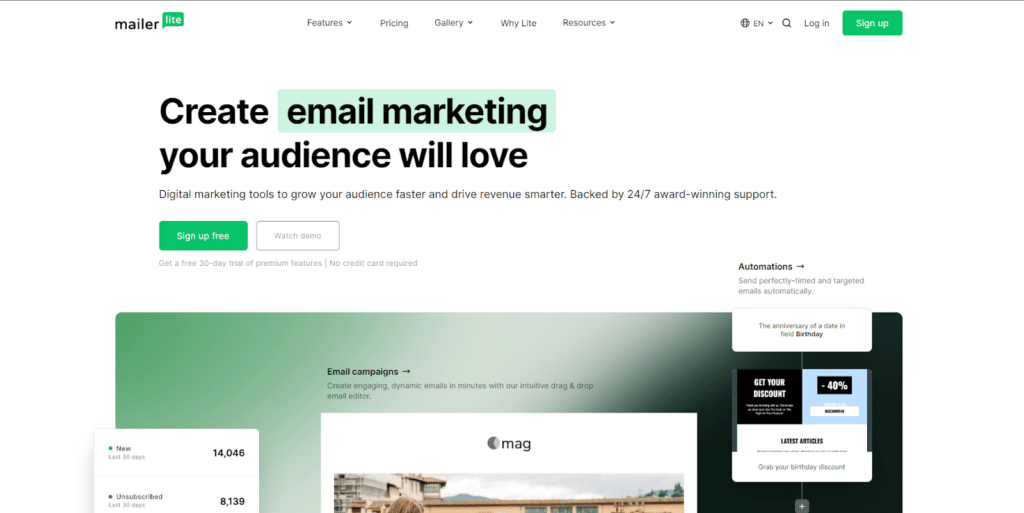
MailerLite makes professional-grade email marketing accessible for cash-strapped creators like freelance writers, graphic designers, artists, musicians, photographers, and other solo creative professionals or small creative shops.
Key features catering to this audience include permanently free and low-cost plans allowing up to 1,000+ subscribers, beautifully designed templates specifically tailored for visual portfolios and new product launches, embedded popup and slide-in forms to easily grow email lists from website traffic, detailed subscriber analytics tracking geolocation, clicks, links clicked, and more to better understand your audience, and round-the-clock customer support availability through live chat, email, phone, community forums, and an extensive online knowledge base.
Together this makes MailerLite an ideal starter email platform for individual creators wanting to promote their work and nurture their small but dedicated fan bases without large marketing budgets.
What makes MailerLite a better alternative than Drip:
- A permanently free plan allows up to 1,000 subscribers making it feasible even for freelancers starting out without a big audience or budget.
- Portfolio campaign templates designed specifically for photographers, graphic artists, musicians and more come pre-loaded with eye-catching creative layouts to showcase visual work.
- Embedded pop-up and slide-in forms for websites make it easy for visitors to join your mailing list without leaving the page they’re viewing.
- Detailed tracking shows real-time subscriber activity like geolocation, clicks, device type, links clicked and more so solo creators can understand their audience.
- Round-the-clock customer support is available through live chat, email tickets, phone, forum and an online knowledge base should any issues arise.
7. Campaigner
Best for Advanced Segmentation ($59/Month)
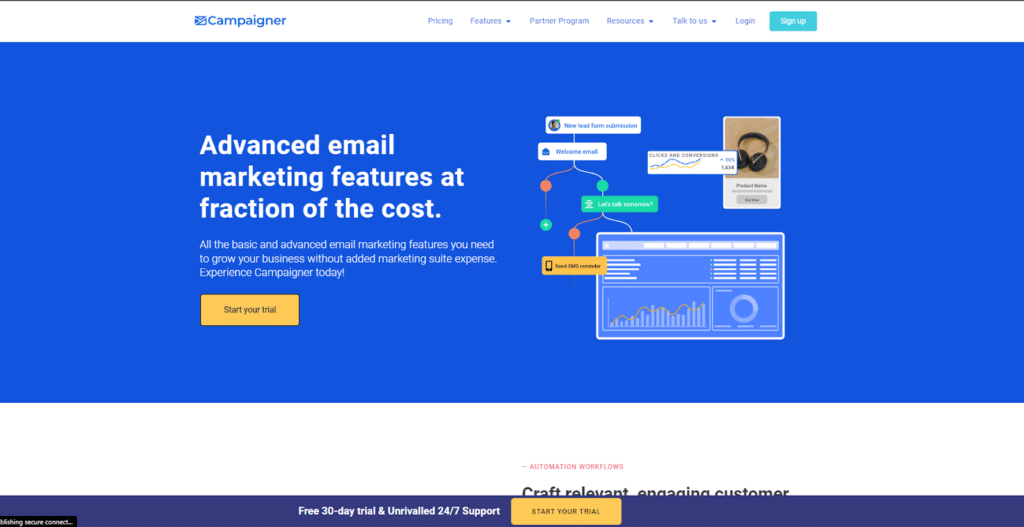
Campaigner stands apart from other email marketing platforms with its powerful segmentation capabilities fueled by artificial intelligence and sophisticated machine learning algorithms.
This functionality enables brands to divide their audiences into highly specific segments based on various behavioral, engagement, predictive or lookalike indicators. Campaigner then facilitates real-time hyper-targeting of email content, messaging cadences, send-times and more for each segment.
Key features driving success for customer-obsessed B2C companies include AI-powered automatic personalization that customizes images, CTAs, text blocks, etc. for each subscriber without heavy manual effort; contact-level data intelligence detailing granular individual preferences, habits and engagement; the ability to build custom scoring models using Campaigner’s robust attribution or integrated third-party data signals.
What’s more is that there are automated recommendations that identify the best high-performing segments to message, ideal send-times, and optimal frequency based on past performance; and easy-to-configure workflow automations involving sequences, triggers, delays and more.
What makes Campaigner a better alternative than Drip:
- AI-powered seamless personalization automatically customizes email content like images, calls to action, text and more for each subscriber without extensive manual personalization.
- Contact-level data intelligence provides granular insight into individual subscriber engagement, preferences and habits enabling you to tailor outreach accordingly.
- Custom scoring models can be built using Campaigner’s platform-driven data or integrated third-party data for precision targeting of high-value lookalike contacts.
- Automated recommendations identify optimal send times, the best-performing segments to prioritize, and frequency capping alerts to maximize engagement while minimizing fatigue and opt-outs.
- User-friendly workflow automations require no coding know-how to set up sequences, triggers, wait periods, delays and more based on open, clickstream, and activity metrics.
8. BigMailer
Best for Large Companies (Free, then $5/Month)
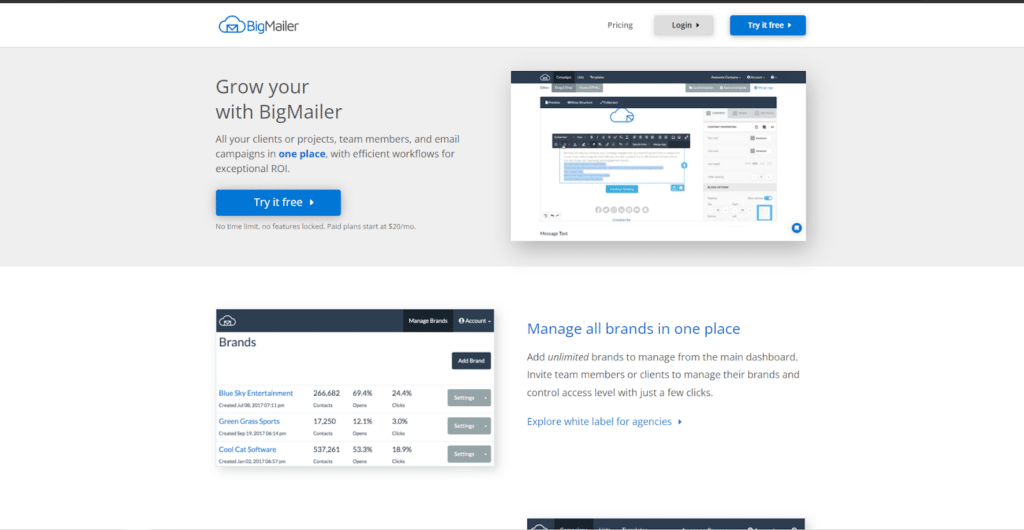
BigMailer is an enterprise-grade email marketing platform built to handle an extremely high volume of emails per month into the billions while still maintaining sophisticated targeting, automation and personalization capabilities. This makes it uniquely suited for major enterprises, high-growth unicorn startups, mega digital agencies, Fortune 500 retailers, and other established brands sending massive promotional email campaigns and newsletters to tens or hundreds of millions of subscribers…
What makes BigMailer better than Drip:
- Scalable infrastructure reliably delivers hundreds of millions of emails per month making it ideal for mega ecommerce store promotions.
- Graphical workflow builder allows you to use drag and drop conditional logic to create complex subscriber journeys with custom triggers and criteria.
- Send time optimization and advanced queue prioritization ensure your biggest blasts are smoothly delivered across ISPs to maximize engagement and avoid SPAM/deliverability issues from sudden massive volume.
- Multi-step and event-based forms facilitate seamless subscriber onboarding with partial saves, notification pings and automated messaging guiding users along their journey to drive higher back-end conversion.
- Enterprise-grade security protocols like 2-factor authentication, role-based permissioning for team members, IP restriction controls and more keep your data safe as you scale up.
9. Constant Contact
Best for Ease of Use ($12/Month)
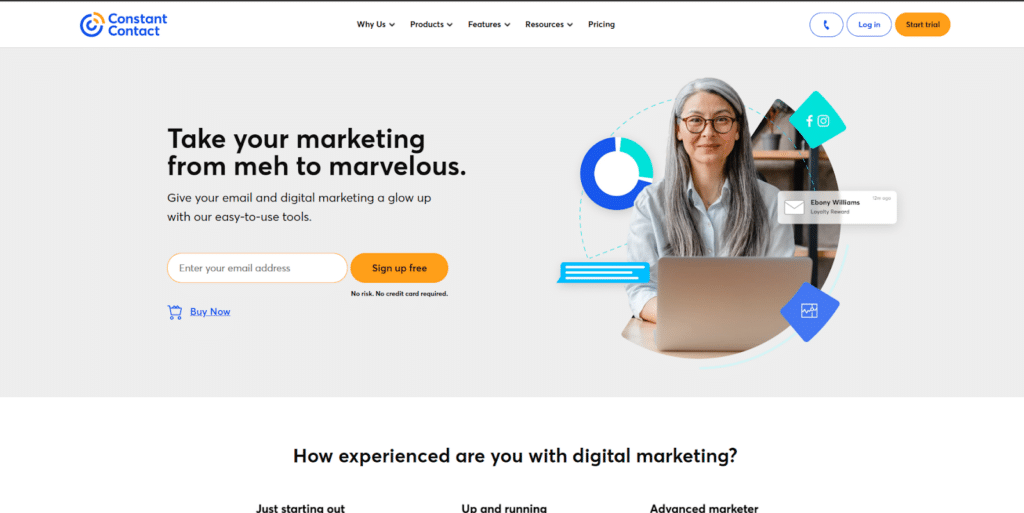
Constant Contact simplifies email marketing for offline-based small businesses like restaurants, retail shops, salons and others lacking extensive technical skills or marketing expertise. Intuitive tools focus on beautiful email templates, contact management, scheduled email sends, and integration with Google/Facebook ads management.
What makes Constant Contact a better alternative than Drip:
- Hundreds of professional, mobile-optimized email templates suited for announcements, promotions, newsletters and more provide an on-brand starting point for small businesses to look polished.
- Event marketing features facilitate promotion of and engagement with in-person events, fundraisers, conferences, and workshops important to offline-based businesses.
- Real-time sales activity tracking provides insight into email effectiveness at driving in-location purchases, phone calls, coupon redemptions and other conversions without relying solely on web analytics.
- Top-rated onboarding resources like step-by-step getting started guides, explainer videos, weekly live trainings and email course offerings help you learn email best practices on your schedule.
- Simple pricing starts as low as $20 per month making email marketing affordable alongside other real-world business expenses facing small storefronts or medical/law offices.
10. GetResponse
Best for Driving Repeat Purchases (Free, then $15.58/Month)
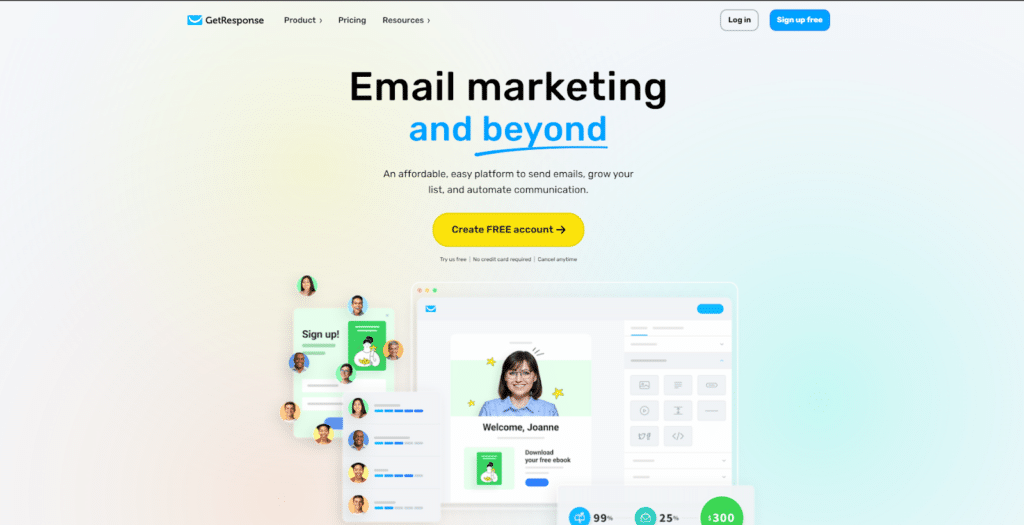
GetResponse offers advanced email marketing tightly integrated with webinars, landing pages, marketing automation, and CRM for complete optimization of the lead-to-loyal customer journey. Segmentation, workflows and personalization specifically help ecommerce brands continually re-engage customers to drive repeat sales.
What makes GetResponse better than Drip:
- Intelligent email follow-ups triggered by customer behaviors like cart abandonment, multiple failed payments, or periods of inactivity tempt subscribers back to complete intended purchases. These automations are easy to set up even for those without extensive coding skills and facilitate ongoing nurturing of your subscriber base to increase customer lifetime value over time. GetResponse focuses heavily on these capabilities specifically for ecommerce merchants and brands selling online.
- Contact scoring based on engagement metrics, lifetime value, and other dynamics allows for tiered customer journeys tailored to the needs of top buyers vs potential one-time shoppers. Advanced segmentation means your messaging matches subscriber preferences.
- Machine learning capabilities enable dynamic content blocks in emails to display different products, offers, or messaging tailored to individual subscriber preferences and habits. This level of personalization drives open and click-through rates.
- Built-in webinar functionality lets you educate subscribers on products, facilitate Q&As with star customers, and drive sales through limited-time promo codes redeemable by webinar attendees. Webinars integrate seamlessly with email marketing campaigns.
- CRM integration gives fuller visibility into the subscriber journey before and after email sends, illuminating the direct impact of campaigns on metrics like customer lifetime value over time. This connects messaging to bottom line revenue growth.
11. Benchmark Email
Best for Email Marketing Agencies (Free Plan, then $13/Month)
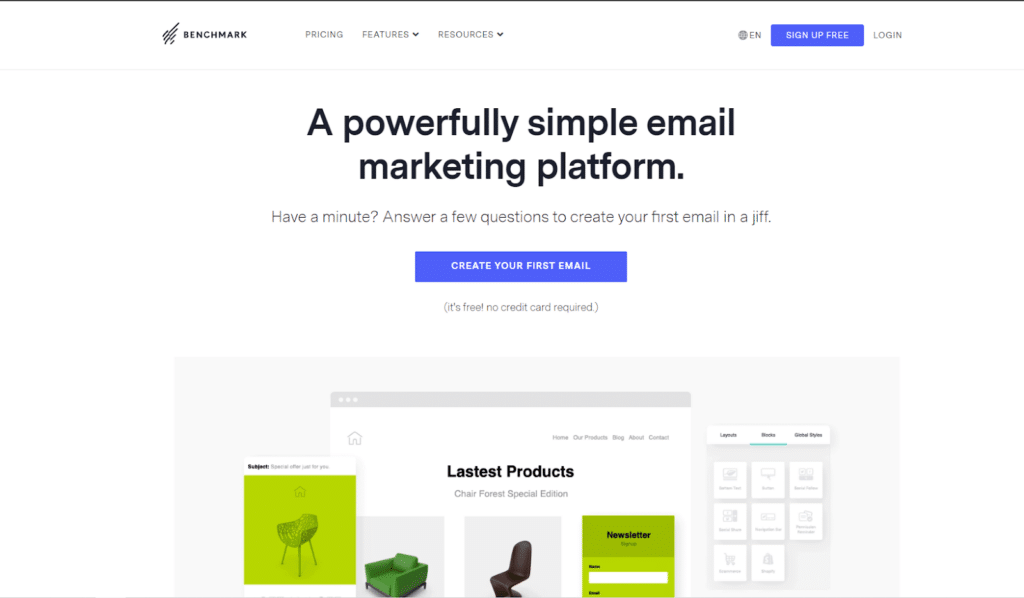
Benchmark Email makes it easy for digital marketing agencies and advertisers to manage email marketing across hundreds of client accounts from a centralized dashboard while keeping campaign data segmented per client. Robust agency-focused tools also facilitate collaboration across teams and provide transparency into client deliverability/engagement.
What makes Benchmark Email better than Drip:
- Manage up to 300,000 subscriber contacts per client account while separating data so it remains invisible between different agency clients for privacy and security. Role-based logins let staff only access permitted accounts.
- Create and save reusable email templates, content blocks, images and code snippets to maintain consistent branding across clients and campaigns. This accelerates campaign creation for multiple accounts without sacrificing customization.
- Real-time metric dashboard breaks down open rates, click rates, unsubscribes and more for each client campaign to spot lags in engagement quickly before issues compound. Instant visibility aids optimization.
- IP pooling with over 140,000 dedicated IPs guarantees your client accounts have access to sufficient sending power and protection against blacklisting should one IP gather spam complaints. Deliverability stays reliable despite managing many accounts.
- Transparent pricing starts free for up to 2,000 contacts making it affordable for fledgling agencies getting off the ground while still facilitating advanced functionality. Pay only as you scale up.
12. Sender
Best for Shopify Integration (Free then $19/Monthly)
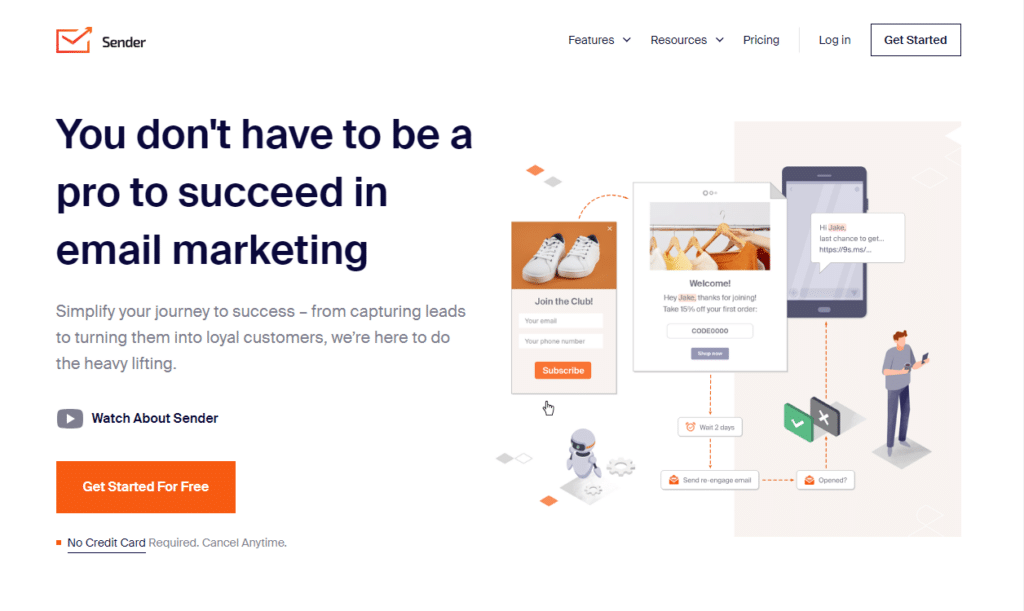
Sender offers advanced email marketing, SMS and post-purchase workflows tightly integrated with Shopify for streamlined optimization of subscriber journeys. Automations connect directly with store events to trigger timely messaging.
What makes Sender better than Drip:
- Shopify-powered segmentation instantly groups contacts by products purchased, order frequency, lifetime value and other metrics without any importing or syncing across platforms. This makes dividing audiences for targeted campaigns easy and dynamic.
- Post-purchase flows automatically enroll buyers into relevant multi-message journeys to encourage repeat purchases based directly on checkout behaviors. No tedious workflow creation needed.
- Intelligent browse abandonment triggers targeted email or SMS to subscribers who recently viewed specific products or collections, tempting them to return with timely offers. Recover lost sales opportunities.
- Automated multi-channel welcome series combines custom email, SMS, and push notifications to onboard new subscribers based on preferences selected at signup. Streamline subscriber onboarding.
- Unified cross-channel analytics within Shopify’s central dashboard give holistic visibility not possible with external tools while still facilitating advanced builds. Single source of truth reporting.
1. Ease of Use
Ease of use should be a top consideration when evaluating Drip alternatives. If the platform has a steep learning curve, requires extensive coding skills, or is overly complex in its feature set, it will be difficult for your team to use it effectively regardless of functionality.
Intuitive interfaces, clear navigation, and thoughtful workflows directly impact your ability to create campaigns, automations and segments quickly. This translates to getting campaigns launched faster, reduced demands on your designers and developers, and maximized adoption across your organization.
Advanced functionality matters little if nobody actually leverages it, or it bogs down broader productivity. Prioritize solutions with simple drag-and-drop builders, customizable templates to accelerate asset creation, and self-service options to reduce reliance on support tickets. The easier it is to create high quality emails and landing pages on your own, manage subscriber data, navigate analytics, and leverage platform capabilities with minimal training time, the better.
2. Design and Customization
A platform’s design and customization capabilities should factor heavily into your buying considerations. Email marketing success hinges on creating well-designed, visually engaging messages and landing pages tailored specifically to your brand identity and audience preferences.
This optimization starts with pre-designed templates covering different campaign goals, integrations with your CMS or ad platforms, drag-and-drop builders for quick changes, WYSIWYG editors for personalizing content blocks, and flexible tools to implement custom CSS/HTML.
Assembling aesthetically pleasing, mobile-responsive designs, imagery, copy and layouts that align to your brand guidelines takes considerable effort. Leveraging templates, reusable content blocks, and intuitive editing tools can greatly accelerate this to focus creativity on personalization.
Prioritizing fighting rigid templates also ensures your unique brand shines vs getting lost in homogenized, generic outreach. The better a solution facilitates customization for on-brand, audience-aligned messaging, the more effective your campaigns will be at driving engagement and conversions.
3. Blogging Tools
Built-in blogging capabilities or tight blog integrations should hold weight when comparing Drip to alternatives. Email marketing and blogging have tremendous synergy for subscriber engagement and list growth. Your blog offers a continuous stream of high-quality content to pull into campaigns boosting value. Embedding signup forms or links within posts fuels subscriber acquisition.
Promoting new posts via email to your audience drives traffic. And blog content offers personalization fodder for segmenting contacts based on interests and engagement with topics or categories.
This virtuous cycle becomes harder to nurture without native blogging functionality or at least integration with leading platforms like WordPress. Evaluating tools to manage post creation, implement calls-to-action within content, easily migrate blogs to email templates, track open and click rates back to source blog content, and even trigger campaigns based on user engagement with posts is crucial. The key is ensuring your platform choice facilitates this channel interplay for maximized ROI.
4. E-commerce Capabilities
For brands selling online, prioritizing ecommerce-specific email marketing capabilities should strongly inform your platform evaluation. Tight integration with your ecommerce platform or CMS creates invaluable subscriber data segmentation, personalization and automation opportunities based on purchase activity.
This powers workflows like abandoned cart or browse abandonment triggers, personalized product recommendations, customer win-back messaging after periods of inactivity, loyalty-reward campaigns for top customers, and post-purchase review request prompts. Surface-level integrations offer basic import/export of subscriber and campaign data.
Deeper capabilities provide access to customer lifetime value, order history attributes, browsing behavior, cart contents in real-time and more for hyper-targeting without manual imports. They also enable effects tracking from email sends directly back to online store metrics like revenue.
This closed loop optimization, triggered messaging based on real-time store interactions, value-based tiered journeys and unified data is incredibly impactful for customer engagement and sales. Prioritizing these ecommerce-specific capabilities pays dividends.
5. SEO Tools
When researching Drip alternatives, incorporated SEO functionality should also receive strong consideration. Email marketing naturally complements SEO efforts through tactics like promoting new site content, encouraging social shares, integrating email signups into content for subscriber list growth, and even triggering campaigns based on site traffic sources. But the right SEO-focused features can take these synergies even further.
Prioritize platforms offering embedded signup forms optimized for search crawling (without impacting conversions), list segmentation based on traffic source and site page behavior, email rendering suited for search engine readability, campaign content automatically formatted for safe website embedding, and analytics tying email effectiveness back to goals like rankings and organic traffic lift.
The key is choosing a solution allowing you to align email, SEO and wider digital marketing programs for maximized exposure and visibility into how messaging drives concrete bottom-line impact. Rather than constant manual tracking across siloed tools, automatic data connectivity, and consolidated performance dashboards add tremendous efficiency.
6. Integrations
When comparing Drip to alternative email marketing platforms, their integration capabilities warrant significant weight in decision making. The best solutions provide deep connectivity with an array of complementary martech and SaaS tools you likely already leverage related to your CMS, CRM, analytics, chat, payments/financing, subscription billing, community forums, help desk and more.
This creates a powerful ecosystem effect improving functionality, removing tedious manual tasks, and streamlining data accessibility across previously disjointed systems.
Rather than constant exports, imports and transfer of subscriber/customer data between platforms, robust APIs enable two-way syncing. The result is instantly updated lists, shared attributes, and visibility into subscriber engagement outside of email.
Workflows also simplify thanks to triggers that can instantiate campaigns based on community forum posts, help desk tickets, custom database updates in your CRM and countless other events. Evaluating both the depth of existing integrations as well as flexibility for further connectivity is critical, as they multiply productivity gains.
7. Analytics and Reporting
Robust analytics and reporting tools should feature prominently when researching Drip alternatives. The success of your email marketing hinges directly on having clear visibility into subscriber engagement and campaign performance coupled with the segmentation flexibility to take action on insights uncovered.
Core reporting on metrics like open, clickthrough and bounce rates, unsubscribe frequency, delivery rates, social shares and more need robust filters to dial into granular cuts by campaign, segment, date range, content types and other attributes. This empowers creating higher-converting messages and journeys.
But combining email analytics with cross-channel visibility related to your website, ads, chat, community and more is even more powerful for connecting how messaging drives bottom-line revenue. This complete picture paired with segmentation tools enables creating increasingly targeted, personalized and timely campaigns across channels and converting subscribers into loyal brand advocates over time.
Allocating significant priority to analytics quality, depth of insights provided both within email and across the customer journey, flexibility in reported dimensions, and how easy insights are to act on ensures maximum ROI.
8. Customer Support and Community
The level of customer support and size of the user community around an email marketing platform also deserves strong consideration when researching Drip alternatives. Regardless of tool robustness, questions and issues invariably arise when managing complex campaigns, debugging deliverability issues as inboxes update filters, optimizing workflows, leveraging newer platform capabilities and more.
Delays in accessing help can severely reduce team productivity and effectiveness. Comparing each platform’s support access channels (phone, chat, email, forums, documentation searches, etc), availability for assistance (24/7 or limited windows), typical response times, knowledge level of representatives, and any priority routing for premium customers provides helpful scoring.
Equally important is assessing the breadth and activity level of related online product forums and networking groups. Beyond serving as an added outlet for troubleshooting insights from peer users, they provide valuable feedback on emerging platform functionality, best practices using new features, and workarounds to common problems. Prioritizing these elements ensures a smoother customer experience.
9. Pricing
Pricing deserves careful examination when reviewing Drip against alternative email marketing platforms. Cost factors heavily into product adoption, toolset maturity and overall ROI. Be wary of solutions touting extremely low introductory offers that bait-and-switch to rigid contracts with recurring fees outpacing value delivered.
Instead scrutinize the full pricing model across needs from list size to advanced features to implementation and delivery; identify where variable charges may arise tied to usage, storage, contacts and functionality. Calculate total cost of ownership for your projected use case across a full year including fees, extras and discounts.
Some solutions provide basic plans attractive to very small businesses but then impose arbitrary limits on deliverability, storage and functionality at higher tiers while spiking costs. Others shine through transparent pricing that scales smoothly without surprise penalties.
Don’t over-prioritize discounts upfront that encourage getting locked into platforms not meeting needs. But do leverage free-trial periods to experience the product rather than judging by price points alone. Align spending with maturity of capabilities, depth of feature set, and total value realized by your marketing program.
10. Reviews and Reputation
When evaluating alternatives to Drip, a platform’s reviews and industry reputation should not get overlooked. Reputation and the broader experience of peer users reported online serve as crucial validation points before investing in any solution. Key markers to consider include: Is the tool G2 and other reputable review sites ranking the platform highly across evaluation criteria aligned with your needs? Are published external reviews predominantly favorable?
Does the provider have strong name recognition in the email marketing space reflected by recommendations from influencers and non-affiliated publications? Have they received best-in or leader-in awards from trusted research firms like Gartner, Forrester, and similar? Are their clients recognizable brand names indicating efficacy?
The more affirmative signals confirming the solution, technical team and customer experience are sound, the lower your product risk. While reviews always require critically assessing potential biases or manipulation, patterns across sources build credibility.
For core platform capabilities expected to drive major marketing initiatives, limiting adoption risks enables greater success faster by leveraging the experience captured from tens of thousands of other customers.
While Drip offers advanced functionality tailored specifically for ecommerce businesses, it has its downsides leading many users to seek out alternatives better aligning with their needs and budgets.
Throughout this piece, we explored the top alternate email marketing platforms on dimensions ranging from core capabilities, to ecommerce focus, ease of use and support ecosystem.
Taking time to review multiple solutions against your specific needs and use case results in the best fit. Testing the platforms yourself via free trials can further validate the right technology investment saving time and money long-term. Just don’t default purely to the incumbency of a tool like Drip without considering if better options now exist.
The table below shows my top five Drip alternatives based on standout strengths:
Brevo
Brevo is packed with all kinds of useful email marketing tools, that make it the best Drip alternative
Omnisend
Omnisend is an excellent choice for various eCommerce activities and email marketing campaigns
HubSpot
Efficient lead flows and campaign sequences make HubSpot perfect for lead generation
ActiveCampaign
If you need advanced automation features, then ActiveCampaign is the email marketing tool for you
AWeber
AWeber is perfect for smaller businesses that are just starting out with email marketing campaigns





